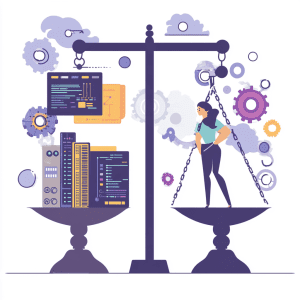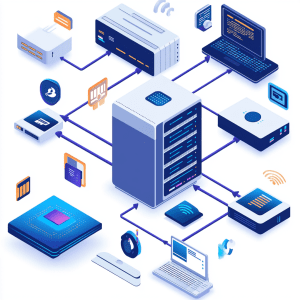Hardware vs. Software: Making Smart Technology Investments for Your Small Business
 As a small business owner, you’re constantly faced with tough decisions about where to invest your limited resources. When it comes to technology, one of the most challenging balancing acts is determining how much to spend on hardware versus software. Make the wrong choice, and you could end up with expensive equipment that doesn’t run the programs you need—or sophisticated software that crawls along on outdated machines.
As a small business owner, you’re constantly faced with tough decisions about where to invest your limited resources. When it comes to technology, one of the most challenging balancing acts is determining how much to spend on hardware versus software. Make the wrong choice, and you could end up with expensive equipment that doesn’t run the programs you need—or sophisticated software that crawls along on outdated machines.
At RZR Solutions, we’ve guided countless North Texas small businesses through this decision-making process. The truth is, there’s no one-size-fits-all answer. Your specific business needs, growth plans, industry requirements, and budget all play crucial roles in finding the right balance.
In this comprehensive guide, we’ll walk you through the essential considerations for both hardware and software investments, help you identify your business’s unique needs, and provide a framework for making technology decisions that drive growth rather than drain your resources.
“Technology is best when it brings people together.” – Matt Mullenweg, founder of WordPress
By the end of this article, you’ll have a clearer understanding of how to evaluate your technology needs and make investments that position your business for success both now and in the future.
Understanding the Hardware vs. Software Relationship
Defining Hardware and Software in Business Terms
Before diving into investment strategies, let’s clarify what we mean by hardware and software in a business context:
- Hardware refers to the physical technology components your business uses—computers, servers, networking equipment, printers, mobile devices, and specialized equipment specific to your industry. These are tangible assets you can touch and see.
- Software includes all the programs, applications, and digital tools that run on your hardware—from your operating systems and Microsoft Office 365 to specialized industry applications, cloud services, and cybersecurity solutions.
The Symbiotic Relationship
Think of hardware and software as two halves of the same whole—neither functions optimally without the other. Your business needs both elements working in harmony:
- Even the most powerful software becomes frustratingly slow on outdated hardware
- The most expensive hardware provides little value without the right software to accomplish your business tasks
- Software requirements often drive hardware decisions (not the other way around)
Common Misconceptions Among Small Business Owners
In our years of providing managed IT services to North Texas businesses, we’ve encountered several persistent myths:
Myth #1: “I need to buy the latest and most expensive hardware to stay competitive.”
Reality: Many small businesses over-invest in hardware capabilities they’ll never utilize while under-investing in the software that directly impacts productivity.
Myth #2: “Free software is always a good way to save money.”
Reality: Free software often lacks critical security features, integration capabilities, and support—potentially costing far more in downtime, data loss, or security breaches than paid alternatives.
Myth #3: “Once I buy my technology, I won’t need to think about it for years.”
Reality: Technology requires ongoing maintenance, updates, and eventual replacement. Both hardware and software investments should be viewed as cyclical rather than one-time expenses.
According to a Gartner report, small businesses that strategically balance their hardware and software investments typically see 15-25% better returns on their technology spending compared to those who make haphazard purchasing decisions.
Understanding this fundamental relationship is the first step toward making smarter technology investments for your business. Next, we’ll explore how to assess your specific business needs.
Assessing Your Business Technology Needs

Before opening your wallet for any technology purchase, you need a clear understanding of your business requirements. This strategic approach ensures you invest in solutions that address real business needs rather than getting distracted by flashy features or unnecessary upgrades.
Essential Questions to Ask Before Making Technology Purchases
- What business problems am I trying to solve? Identify specific operational challenges, inefficiencies, or growth limitations.
- How will this technology directly impact my bottom line? Consider productivity gains, error reduction, customer experience improvements, or new revenue opportunities.
- What are my current and anticipated workloads? Factor in number of users, data processing requirements, and peak usage periods.
- What industry-specific requirements do I need to meet? Consider compliance regulations, data security standards, and specialized functions.
- How does this fit into my broader business technology plan? Avoid isolated purchases that don’t integrate with your existing systems.
Distinguishing Between “Must-Have” and “Nice-to-Have” Technology
When evaluating any technology solution, use this simple framework to categorize features:
| Critical Functions | Important Features | Bonus Capabilities |
|---|---|---|
| Business stops without these | Significantly improve operations | Provide incremental benefits |
| Core security protections | Advanced threat monitoring | AI-driven security prediction |
| Basic document creation | Team collaboration tools | Advanced analytics dashboard |
| Local data backup | Cloud backup redundancy | Instant virtual machine recovery |
This prioritization helps ensure your core business needs are met before investing in advanced capabilities that might not deliver immediate return on investment.
Planning for Scalability and Future Growth
A common and costly mistake is purchasing technology that meets only your current needs. According to a SMB Group study, 68% of small businesses end up replacing technology solutions within 2 years because they failed to consider future growth.
“The best technology investments solve today’s problems while accommodating tomorrow’s growth.” – RZR Solutions Technology Planning Guide
When assessing scalability, consider:
- Projected employee growth over the next 2-3 years
- Anticipated changes in customer base or market expansion
- Potential new product or service offerings
- Evolving industry regulations and requirements
- Technology trends affecting your industry
At RZR Solutions, we help small businesses in North Texas create technology roadmaps that account for both immediate needs and future growth. This strategic approach prevents wasteful spending cycles and ensures your technology evolves alongside your business.
Once you’ve clearly identified your business requirements, you can make more informed decisions about specific hardware and software investments—which we’ll explore in the next sections.
Hardware Investment Considerations

Hardware forms the physical foundation of your business technology infrastructure. Making smart hardware investments requires balancing performance needs, budget constraints, and longevity considerations.
Essential Hardware Components for Small Businesses
While every business has unique requirements, these core hardware components form the backbone of most small business operations:
Workstations/Computers
The daily productivity tools for your staff—consider processing power, memory, and storage based on typical usage patterns.
Pain Point: Outdated workstations can cost up to 42 minutes in productivity per employee per day according to a 2023 Intel study.
Servers
For businesses requiring local applications, file storage, or specialized operations—though many functions are increasingly moving to cloud platforms.
Pain Point: Server failures cause an average of 87 minutes of downtime, costing small businesses $427 per minute according to Gartner.
Networking Equipment
Routers, switches, access points, and cabling that connect your business to the internet and enable internal communications.
Pain Point: Inadequate networking infrastructure leads to connectivity issues that frustrate employees and customers alike.
Learn more about proper network management for reliable business operations.
Security Hardware
Firewalls, physical security components, and specialized devices that protect your digital assets.
Pain Point: 43% of cyber attacks target small businesses, with the average cost of a data breach exceeding $200,000.
Discover how RZR Solutions’ cybersecurity services can protect your business.
Longevity vs. Cost: Finding the Right Balance
One of the most challenging aspects of hardware purchasing is determining how much to invest upfront for longer-term performance. Consider these guidelines:
| Component | Typical Lifespan | Investment Strategy |
|---|---|---|
| Workstations | 3-5 years | Mid-tier with room for upgrades often provides the best ROI |
| Servers | 5-7 years | Higher initial investment typically pays off through reliability and performance |
| Networking | 5-8 years | Quality components reduce troubleshooting and downtime costs |
| Mobile Devices | 2-3 years | Consider lifecycle management programs for consistent upgrades |
“The bitterness of poor quality remains long after the sweetness of low price is forgotten.” – Benjamin Franklin
When to Invest in Premium Hardware
Not all hardware requires top-tier investment. Here’s when to consider premium options:
- For mission-critical systems where downtime directly impacts revenue
- For specialized workloads like graphic design, video editing, or data analysis
- For security components protecting sensitive customer or business data
- When regulations or compliance requirements dictate specific hardware capabilities
Ownership vs. Hardware-as-a-Service
Traditional hardware purchasing isn’t the only option. Modern businesses can benefit from alternative acquisition models:
Hardware-as-a-Service (HaaS)
Similar to leasing—fixed monthly payments cover hardware, maintenance, and regular upgrades.
Benefit: Predictable costs, automatic technology refreshes, and reduced capital expenditure.
Hybrid Models
Own long-term assets while subscribing to services for rapidly evolving technologies.
Benefit: Optimize cash flow while maintaining control of critical infrastructure.
At RZR Solutions, we help North Texas small businesses evaluate these options based on cash flow requirements, tax considerations, and technology lifecycle management needs.
Hardware decisions should never be made in isolation. In the next section, we’ll explore the equally important software considerations that complete your technology ecosystem.
Software Investment Considerations

While hardware might be the visible face of your technology investments, software is often where the real business value lies. The right software solutions can dramatically improve efficiency, provide competitive advantages, and enable business growth—but navigating the complex software landscape can be challenging.
Subscription-Based (SaaS) vs. One-Time Purchase Software
One of the most significant shifts in business software has been the move from perpetual licensing to subscription-based Software-as-a-Service (SaaS) models. Understanding the pros and cons of each approach is crucial:
| Consideration | Subscription/SaaS Model | One-Time Purchase |
|---|---|---|
| Initial Cost | Lower upfront investment | Higher initial expense |
| Long-term Cost | Ongoing payments may exceed one-time purchase over time | Potentially lower total cost of ownership for long-term use |
| Updates & Features | Regular updates and new features included | May require additional purchases for major updates |
| Accessibility | Often cloud-based with anywhere access | Typically installed on specific devices |
| Scalability | Easy to add/remove users as needed | May require additional licenses for growth |
For many small businesses, the flexibility and lower initial investment of SaaS solutions like Microsoft 365 make them increasingly attractive options. However, specialized software with stable feature requirements might still be more economical as a one-time purchase.
Custom vs. Off-the-Shelf Solutions
Another critical decision is whether to use standardized software packages or invest in custom-developed solutions:
Off-the-Shelf Software
Best for: Common business functions with standardized processes
Advantages: Lower cost, immediate implementation, established support
Disadvantages: May require adapting your processes to the software’s workflow
Custom Software
Best for: Unique business processes or competitive differentiators
Advantages: Tailored to your exact needs, potential competitive advantage
Disadvantages: Higher initial cost, longer implementation time, ongoing maintenance requirements
Learn how RZR Solutions’ web app development can create custom solutions for your business.
According to a McKinsey Digital report, businesses should consider custom development when the function provides direct competitive advantage or when existing solutions would require extensive modifications.
Integration Capabilities: The Hidden Software Cost
One of the most frequently overlooked aspects of software investment is integration—how well new solutions work with your existing technology ecosystem:
Pain Point: According to a recent study, employees waste up to 60 minutes daily switching between applications and transferring data between non-integrated systems.
Before investing in any software, consider:
- Does it integrate with your existing critical applications?
- What is the cost (both financial and time) of integration?
- Will you need middleware or custom connectors?
- Does the vendor provide APIs or integration support?
RZR Solutions approach: We evaluate your entire technology ecosystem to ensure new software enhances rather than complicates your operations.
Security and Compliance Factors
Software plays a critical role in maintaining your business’s security posture and regulatory compliance:
- Security considerations: Data encryption, access controls, vulnerability management, and update policies
- Compliance requirements: Industry-specific regulations (HIPAA, PCI-DSS, GDPR, etc.) that may dictate specific software capabilities
- Vendor security practices: How the software provider handles your data, especially for cloud-based solutions
Our compliance services ensure your software investments meet regulatory requirements while our network monitoring provides ongoing security oversight.
“Security isn’t something you buy, it’s something you implement and maintain through proper software selection and ongoing management.” – RZR Solutions Security Guidelines
Making informed software decisions requires balancing immediate functional needs with long-term strategic considerations. In the next section, we’ll explore how to find the right balance between hardware and software investments.
Finding the Right Balance

The most successful small businesses don’t view hardware and software decisions as separate challenges—they approach technology as an integrated ecosystem where each component must complement the others to deliver maximum business value.
Common Imbalance Scenarios
In our experience serving North Texas small businesses, we frequently encounter these imbalance scenarios:
The “Premium Hardware” Trap
Businesses invest in top-tier hardware but run basic software that doesn’t utilize the hardware’s capabilities.
Result: Wasted capital investment and delayed returns on technology spending.
Example: A small accounting firm purchases high-end workstations but continues using basic spreadsheet applications for financial management instead of leveraging specialized accounting software.
The “Software Overload” Problem
Businesses subscribe to advanced software packages but run them on aging hardware that can’t handle the processing demands.
Result: Poor performance, frustrated employees, and failure to realize software benefits.
Example: A marketing agency subscribes to the latest design software suite but runs it on 5-year-old computers with insufficient RAM and processing power.
The “Fragmented Technology” Situation
Businesses make hardware and software decisions independently without considering integration needs.
Result: Incompatibility issues, manual workarounds, and productivity bottlenecks.
Example: A healthcare provider implements new practice management software without ensuring compatibility with existing hardware and patient record systems.
Creating a Balanced Technology Budget
While every business has unique needs, these general guidelines can help create a balanced technology budget:
Recommended Technology Budget Allocation
- Hardware: 30-40% of total technology budget
- Software: 30-40% of total technology budget
- IT Services & Support: 15-25% of total technology budget
- Training & Implementation: 5-10% of total technology budget
Overall technology spending typically ranges from 2-7% of annual revenue for most small businesses, depending on industry and technology dependence.
According to Spiceworks’ State of IT report, businesses that maintain balanced technology investments report 32% higher satisfaction with their technology performance and 27% fewer disruptions than those with skewed allocations.
Real-World Example: Balanced Technology Investment
Case Study: North Texas Professional Services Firm
A 15-person professional services firm in North Texas approached RZR Solutions with performance complaints and inefficient workflows. Their previous approach had been to purchase the least expensive hardware possible while investing in numerous software subscriptions.
Challenge: Employees were spending excessive time waiting for software to load and experiencing frequent crashes.
RZR Solution: We conducted a comprehensive technology assessment and developed a balanced approach:
- Strategically upgraded key hardware components rather than complete replacement
- Consolidated redundant software subscriptions
- Implemented proper network management to improve overall system performance
- Developed a 3-year technology roadmap with balanced investment planning
Results:
- 42% reduction in system latency
- 22% decrease in overall technology spending
- 91% improvement in employee satisfaction with technology
- Estimated productivity gain of 1.2 hours per employee per week
The Technology Roadmap Approach
Rather than making reactive technology purchases, develop a proactive technology roadmap that:
- Identifies business objectives and the technology needed to support them
- Maps current technology assets and their expected lifespans
- Plans strategic refresh cycles that align hardware and software updates
- Allocates budget across a multi-year timeline to avoid feast-or-famine spending
- Incorporates flexibility for emerging technologies and changing business needs
At RZR Solutions, we specialize in developing these customized technology roadmaps for North Texas small businesses, ensuring your technology investments drive business value rather than draining resources.
In the final section, we’ll explore how working with a managed service provider like RZR Solutions can help optimize your technology investments even further.
Working with an MSP for Optimized Investments

For many small business owners, technology decisions can feel overwhelming—especially when



